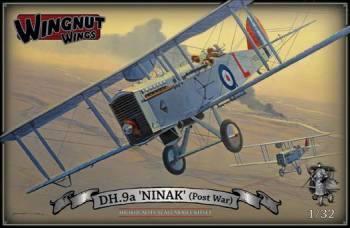The AMC DH.9a (Aircraft Manufacturing Company de Havilland 9a) bomber arrived late in the Great War and was born out of the necessity to find a replacement for the under performing DH.9. Intended as a replacement for the 275-350hp Rolls Royce Eagle powered DH.4, with the pilot and gunner repositioned closer together for improved communications, the DH.9 was in fact a great leap backwards due in no small part to the inferior performance and unreliability of its 230hp Puma engine.
Due to the workload at AMC the initial design work for the improved DH.9a was undertaken by Westland Aircraft Works who modified AMC built DH.9 C6350 to accept a 350hp Rolls Royce Eagle VIII engine in anticipation of the imminent arrival of the plentiful 400hp Liberty V12 engine from America. With its larger wings and re-designed nose, C6350 started flight testing in February 1918. The 2nd prototype, and the 1st to be fitted with a Liberty engine, was AMC built C6122 which took to the air on 19 April 1918. In July 1918 it appeared that the supply of Liberty engines could dry up so a 3rd prototype, Westland built B7644, was produced to accept the 350hp Eagle VIII, but as it turned out the supply of Liberty engines proved to be enough for RAF needs.
Remarkably, an initial production order for 400 DH.9a was placed with the Whitehead Aircraft Co in January 1918, a month before the 1st prototype flew. The DH.9a was manufactured by Whitehead, AMC, Mann Eggerton & Co and The Vulcan Motor & Engineering Co as well as numerous rebuilds and small post war production orders from the likes of the de Havilland Aircraft Co, Handley Page Ltd, HG.Hawker Engineering Co Ltd and Short Bros amongst others. An American order for 4000 USD-9A was placed with the Curtis Aeroplane and Motor Company but was canceled due to the Armistice and it appears that only 13 USD-9A were built, all prototypes. At least 2700 unlicensed copies were built in the newly formed Soviet Union as the Polikarpov R-1. Post war developments (as provided in this model) included improved undercarriage, an auxiliary radiator, additional gravity petrol tank and leading edge wing slats. Further developments included a raised "hump back" fuselage and oleo suspension undercarriage.
The DH.9a ‘Ninak’ (Nin = 9, ack = A) entered front line service with the RAF and USMC in late 1918 and went on to lengthy post war service with the RAF in Germany, Russia and the Middle East and saw service in Canada, Australia and in the Soviet Union and China (as the Polikarpov R-1).
Early aircraft colours are contentious at the best of times and we have done our best to provide what we consider to be accurate painting information. Towards the end of 1918 the RAF replaced PC10 with AMAPD (AMA Protective Dope) which contained pigments giving a "dark chocolate brown appearance" and AMAPDT (AMA Protective Dope Tropical) dark reddish brown for aircraft destined for service in the tropics. In the 1920s most aircraft were silver doped overall with their aluminium engine cowlings frequently unpainted. Steel components, fittings and brackets were usually painted black unless overpainted with silver. The Polikarpov R-1 appears to have initially been finished overall in a pale finish (white or silver?) and later with a dark olive green "zashchitnyi" (protective) finish on the upper surfaces and light blue-grey undersides. Almost all Polikarpov R-1 featured extensive political slogans.




















